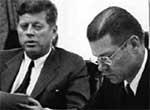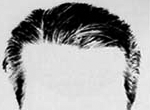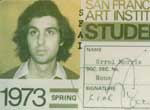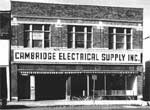Presenting creatives from all across the country who, time and time again, rise above the fray to create work that resonates and inspires
Adweek - January 24, 2005
CREATIVE DIRECTOR
Andrew Keller
Crispin Porter + Bogusky, Miami
Making ads that pierce popular culture is what Crispin Porter + Bogusky does better than any other agency these days--and behind most of those ads for Burger King, BMW Mini and Virgin Atlantic stands a curly haired, outspoken 34-year-old creative director, Andrew Keller. "He's got the mind of a scientist and the heart of an artist," describes Alex Bogusky, ecd and partner at CP+B. "He can kind of build and test a hypothesis. But then [that is] combined with the emotion and love of life and people and process that an artist has."
That makes sense for Keller, who grew up in Atlanta and at first wanted to follow in the footsteps of his father, an oncologist, by going to medical school. Instead, Keller, now father to two sets of twin boys, played bass and guitar in bands before focusing on advertising. While Keller is so organized that he color codes his e-mail, he relates much of what he does to music.
"I look at it as trying to keep creative momentum," says Keller, who plays guitar for agency house band Ironic Trucker Hat. "You're helping people be true to their voice, but creating a whole piece of music that achieves the goals we're trying to achieve."
A Portfolio Center grad who worked as an art director in Portland, Ore., before landing at CP+B in 1998, Keller describes advertising as "an action." "It's not just what you say. It's how you say it, where you say it and when you say it," explains Keller, who was named creative director at CP+B in 2003. "Each piece has the ability to exponentially affect the power of the idea."
Case in point: He was creative director on the BMW Mini launch and last year's "Men of Metal" campaign, which used the Web and voicemail to create a story for devoted Mini users to follow.
Kerri Martin, marketing communications manager for BMW's Mini, based in Woodcliff Lake, N.J., says one of Keller's strengths is his dedication--Keller bought a Mini the day they went on sale, with no discounts. "It really shows his commitment to engaging with the Mini brand, not only as a creative director, but also as a consumer," Martin says.
"He's very analytical in seeing the big picture--always going back to guidelines we've set up for the brand filter," adds acd Rob Reilly. "For Burger King, the voice, we always say, is like a cool uncle, so we'll go through creative ideas that are coming in, and he'll say, 'Well, that doesn't sound like what a cool uncle would say to you.'"
That disciplined approach has helped the $300 million BK account move from ordinary fast-food advertising to a campaign full of quirky characters that have struck a chord with consumers--the "Lunch Break" gang who eat BK in their office together, Dr. Angus, the subservient chicken. Keller, who just wrapped a shoot for Mini work in Rio de Janeiro and is now prepping spots for BK and its bacon cheddar ranch sandwich, says he's most proud of the BK work because it defied industry expectations. "Nobody wanted to believe it was possible to create any sort of sales or create any good work, make anything happen, when we got the account," says Keller. "I still kind of can't believe it."
Keller has a loud, vivacious presence in the office. "He is a strong creative director who keeps the process moving with encouragement and enthusiasm. He will do things to constantly move work forward that he knows is not quite right," says Bogusky. "He's very positive, and he's constantly screaming and yelling--not negatively, but like, 'Oh my god, this is so great, the funniest thing I've ever seen,' even though I know sometimes he doesn't mean it."
In addition to his exuberance and loquaciousness, there's one more trait that people always seem to bring up about Keller--his hair: a reddish-blond, curly afro. "That's just his brand," Bogusky says. "I'm always trying to convince him to grow it out. His wife tries to convince him to cut it. He doesn't know what to do, so he leaves it in the middle and teases it out for photo shoots."
CREATIVE TEAM
Scott Duchon and Geoff Edwards
TBWA Chiat Day, San Francisco
Last year was almost all about the NBA for the recently promoted creative team of Scott Duchon and Geoff Edwards. The associate creative directors' most outstanding commercials for Adidas--"Carry," with Kevin Garnett carrying a throng of people on his shoulders, and "Unstoppable," with Tracy McGrady overcoming a tiny army on the court--will be joined by an equally remarkable spot during the NBA All-Star Game in February, promises ecd Chuck McBride. The brand spot, which will star a number of players, will complete "their trifecta," says McBride.
Copywriter Duchon, 34, is a former GQ Man of the Month best known for creating the Pets.com sock puppet; art director Edwards, 36, is a Detroit native who joined the agency from Element 79, where he worked on Gatorade. The two started working together only last year. While admitting they were wary of "forced chemistry" when McBride first paired them, they found they easily melded their working styles. "He brings a voice; I bring a voice," says Edwards. "Scott is quicker with an idea. I will see every angle of it."
Edwards, who started out as an intern at Chiat/Day in New York 14 years ago and helped Spike Lee launch Spike DDB in 1996, came to McBride's attention with a Gatorade spot, "23 vs. 39," featuring Michael Jordan playing against a younger version of himself. Duchon, a Miami native, began his career as a writer at Crispin & Porter about 11 years ago, then went to J. Walter Thompson in New York for a few years before settling at TBWA C D when it opened in San Francisco in 1998.
McBride says Edwards and Duchon are enthusiastic problem solvers. "I find them to be incredibly tenacious," he says. "A lot of people get worn down by negative process. They take the adversity and use it to their benefit. They come out heroes that way."
The two faced many production hurdles, says executive producer Jennifer Golub, but managed to stay focused and prevailed. "On 'Carry,' we faced daunting technical challenges," she says. "At our first meeting with the stunt crew, the technical crew, Noam Murro and the creatives, we all sat at a big table, and Noam reached out to us and said, 'How the fuck are we going to do this?' But we embraced it, and we worked through it."
Duchon and Edwards say it is easy to be enthusiastic when they work for clients like Adidas and PlayStation. (Duchon did the award-winning PlayStation "Rachet and Clank" campaign.) "I am a product of the '80s," says Edwards, adding that he is part of the hip-hop generation and can identify with the target markets. "I'm that kid, just a little bit older," he says, laughing.
Both also speak about the opportunities they've had to work with people like McBride and Lee Clow. "All this great work is certainly not just us," says Duchon.
Still, they've achieved much in a short time. "People are lucky to have this in their body of work in a lifetime," Golub says. "This is when you look back in advertising and say, 'Those were the good old days.' "
COPYWRITER
Steve Dildarian
Goodby, Silverstein & Partners, San Francisco
Steve Dildarian, the 35-year-old copywriter behind the Budweiser lizards and the brand's latest spokesanimal, the eager young donkey introduced last year on the Super Bowl, knew back in high school that he wanted to write comedy for television. "I was an absurd Honeymooners fan and trivia buff," he says. "I had pictures of Ralph Kramden up on my wall."
In his nine years at Goodby, Dildarian has spent most of his time on Budweiser. He got his early advertising comedy training at Cliff Freeman and Partners in New York, working on Little Caesars, and says his sense of humor is rooted in comedy classics and his upbringing in the New Jersey suburbs. "It's more than just throw a pie in a guy's face and make everyone laugh," he says. "[Cliff] kind of instilled a renegade spirit toward the way I look at work. He taught me, you know, nothing is unrealistic, nothing's too far or too much."
Although he looks and sounds a lot like comedian Ray Romano, colleagues say Dildarian reminds them more of Larry David. "He's a pain in the ass," laughs art director Tyler Magnusson. "He's a very detailed guy. From start to finish, he's always trying to make the work better." Jeff Goodby says Dildarian's humor comes from being a bit of a "weird lone wolf" but that his success on Bud comes from being "totally tireless. He's like these guys that get around the table and write sitcoms in that sort of indefatigable way. They can do it and do it and do it and think and think and think. That's the way he is on Bud."
Dildarian's talents go beyond copywriting. He provides the voice of one of the ad guys in Budweiser's online "Rejected Ads" series and that of the lovable Budweiser donkey. "There is a true sadness to the voice that the donkey needed," explains Magnusson.
Creating dialogue and nuances of personality in the studio is the best part of the job, says Dildarian. He particularly enjoyed creating Louie and Frank, the Bud lizards. Introduced in 1997, they reappeared last year in the Bud Light/ Miller Lite ad spat that mimicked political attack ads. "I had never been involved in something where you see an ad on TV, and two days later we're writing an ad responding to it," Dildarian says. "It was fun."
After nearly a decade at Goodby, Dildarian, who has also worked on Ace, Discover and Saturn, is still technically a freelancer. That gives him time for other interests, like writing TV scripts (he almost got an animated series off the ground a few years back) and painting. His freelance status has become a running joke at the agency. "I get the same flack with my relationship. We've been dating longer than most people are married," says Dildarian, who has been with his girlfriend for 12 years. "I don't do things 'cause you're supposed to, 'cause that's the way everyone does it."
ART DIRECTOR
Bob Barrie
Fallon, Minneapolis
Yes, calling Bob Barrie an All-Star is a little like calling water wet. It's obvious. But it's hard to think of more elegant, sophisticated work last year than Fallon's animated campaign for United Airlines. And in the hands of a lesser craftsman--one unwilling to let the pictures speak for themselves--Time's "Red Border" campaign would probably not have the powerful simplicity that has kept the series going strong for more than 10 years.
"He's a natural," says friend and fellow Fallon art director Dean Hanson. "He makes it look effortless, and I think it is for him."
In an ad world dominated by computer-generated animation and special effects, Barrie--who, after 25 years in the business, still proudly retains the title of art director--decided to use traditional techniques like pencil drawings and painting for the United campaign, to restore some dignity and sophistication to air travel. Plus, Barrie points out, the four-spot campaign gave him a chance to work with some of his heroes, like Academy Award winner Michael Dudok de Wit (Father and Daughter) and nominees Wendy Tilby and Amanda Forbis (When the Day Breaks). The tagline, "It's time to fly," was voiced by Robert Redford. "I've always had a huge fondness for traditional animation," says Barrie, 48. "My kids can't appreciate [the ads]. A frequent business traveler can."
While colleagues praise Barrie for his humility, humor and resiliency, Barrie says his success--he's had 270 entries accepted into The One Show, and won 43 Pencils--comes from being a good reductionist. "I'm able to read complicated briefs and come up with simple solutions," he notes. Barrie says he looks for words and phrases he can highlight that might bring a strategy to life. For United, those words included "highly educated" and "sophisticated" to reach the business travelers the bankrupt carrier sees as key to its long-term health. The idea, Barrie says, also fit well with United's existing brand equity, which includes the longtime use of George Gershwin's "Rhapsody in Blue."
"He never lets any negativity block his thinking," says Stuart d'Rozario, group creative director and copywriter on the United campaign. "I think that's a very common problem [among creatives]."
Rather than appeal to travelers' pocketbooks by touting routes and rates, the campaign tries to re-establish the elegance of flying, using the idea of getting from one place to another as a storytelling device. One spot depicts the roller coaster of emotions a man experiences as he travels to interview for (and eventually land) his dream job. Another shows a business traveler making an extra trip to deliver a rose to his mother.
A native of Green Bay, Wis., Barrie landed in Minneapolis some 30 years ago to study architecture at the University of Minnesota. But after a year and a half in the program, he decided to take his artistic instincts in another direction. (His father was a commercial artist, the 1950s precursor to an art director.) After stints at shops around the Twin Cities (including then-powerhouse Bozell Minneapolis), Barrie joined Fallon in 1983, two years after the agency opened its doors. He's been there ever since, winning nearly every conceivable award in the process. "I'm as insecure as the next guy," he says. "It never gets easy. You constantly have to re-prove yourself. And that's good. It keeps you fresh."
Despite his status as a veteran in a business that reveres youth and rewards with advancement, Barrie has been content to remain an art director, preferring to do the work rather than meet about it. "If my name's on it, you know I had something to do with it," he explains. Also, his artistic interests aren't limited to advertising. Among his hobbies are oil painting and photography. Last year, Barrie, who serves on the board of Smile Network International, used his photographic skills to document a mission for the organization, which helps children with cleft palates get restorative surgeries.
Still, he remains committed to advertising. In fact, he was shocked earlier this year to learn that a colleague at another agency had heard a rumor that he was hanging up his pencil. "I plan on working for the next 20-30 years," Barrie says. "I've got a lot left in me."
AGENCY PRODUCER
Josh Reynolds
Goodby, Silverstein & Partners, San Francisco
When Josh Reynolds, an executive producer at Goodby, Silverstein & Partners, learned that TV Guide recently proclaimed the Hewlett-Packard commercial "Picture Book" as the best 60 seconds on television, he was, of course, thrilled. "It is very gratifying to see your work embraced and hailed by, most importantly, the public, as well as mainstream media sources," the 44-year-old says.
"Picture Book," set to the catchy Kinks tune of the same name, promotes HP's digital photo products by depicting a parade of people grasping frames that magically transform into photographs. Directed by Francois Vogel of Paranoid Projects@Tool, the spot was one of only two hands-on producing projects that Reynolds, who also has management responsibilities at Goodby, tackled last year.
He also produced another visually captivating HP spot, "Constant Change," directed by David Fincher of Anonymous Content. Showing the evolution of a business over time in what appears to be one continuous shot, the ad shows a man walking through an office with his clothes, the background and time of day changing every five frames, to the beats of the Who classic "Baba O'Riley," re-recorded for the occasion by Pete Townshend and his brother Simon Townshend.
"Constant Change" was the more complex job. It involved precise choreography and the use of motion control on a green screen stage, with CG backgrounds and wardrobe painstakingly created in post. "Picture Book" was more straightforward, involving green screen and careful tracking to create the illusion that the people were grabbing photos out of thin air, Reynolds explains.
Both productions were lengthy and intensive. Reynolds spent about 14 weeks, including six weeks of post, on "Constant Change" alone. "Luckily, I've learned to pace myself over the years," he says. "I know when to take things extremely seriously, and I also know when things are not a big deal."
A veteran producer, Reynolds, who didn't attend college, got his start as an actor at the age of 18, appearing in commercials for McDonald's and Country Time Lemonade. Simultaneously, he toiled at a video distributor in Los Angeles, "shrink-wrapping videocassettes of The Godfather and King Kong. That was my college."
Ultimately realizing that he was neither particularly good at acting nor particularly interested in it, Reynolds delved into the ad industry, landing a job as a runner for the in-house editorial department of Chiat/Day in Los Angeles. From there, he developed a career that included stints at J. Walter Thompson in San Francisco; Borders Perrin & Norrander in Portland, Ore.; Foote Cone & Belding in L.A.; and at Nike, running its in-house film and video division.
He had been freelance producing for about eight years when he joined Goodby in 2003, lured by the opportunity to work on HP. Accepting the job meant making major sacrifices: Reynolds commutes to San Francisco from Portland, where he lives with his wife and kids. "I wouldn't do that if it wasn't Goodby," he says.
Goodby's Steve Simpson and John Norman, co-creative directors on HP, are glad that Reynolds is willing to make the trip. Simpson says Reynolds is valued for his creative judgment. "I think that's the key thing about Josh that makes him amazing," he says. "It's rare when a producer is so much a part of the creative team."
Norman praises everything from Reynolds' ear for great music (which he may have inherited from his dad, Nick Reynolds, a member of The Kingston Trio) to his expertise in special effects. "I don't know where Josh picked up his knowledge of special effects," Norman says, "but technically he knows it all really, really well."
DIRECTOR
Errol Morris
Moxie Pictures, New York
Errol Morris has lost track of the Oscar he received last year when his film The Fog of War: Eleven Lessons from the Life of Robert S. McNamara won Best Documentary. "It's tucked away somewhere in the house," the veteran director muses.
While Morris, 57, can't pinpoint the exact location of the Oscar in his Cambridge, Mass., home, he appreciates the honor bestowed on his film, which illuminates the thinking of one of the major architects behind the Vietnam War. "To say that you're indifferent to getting an Oscar is obviously a lie because it is a big thing--not just simply for validation. It's also a big thing in terms of being able to promote a movie," says Morris, whose other documentary credits include A Thin Blue Line (1988), A Brief History of Time (1991) and Fast, Cheap and Out of Control (1997).
Morris was also nominated for the Directors Guild of America Award for Best Commercial Director last year, which might come as a surprise to fans of his documentaries. "It's almost like I have these two separate careers," he says. "I have a career as a documentary filmmaker, and I have a career as a commercial director, and oddly enough, there are people who know me for one and not the other."
Morris earned the DGA nod based on spots he directed in 2003 for Nike, Miller High Life and Cisco. (Morris did all of the work mentioned in this story through @radical.media; late last year he signed with Moxie Pictures.)
In 2004, Morris continued to helm numerous ad campaigns, including the notable "More to See" spots by Wieden + Kennedy, New York, for Sharp Aquos. The gorgeously cinematic ads--including "The Pool," in which a Karmann Ghia crashes into a pool in slow motion--led viewers to moretosee.com, where they were challenged to unravel a mystery.
W+K producer Jesse Wann, who worked with Morris on Sharp, says Morris has an uncanny ability to "find things in the moment. He's not a storyboarder. He has a certain unusual eye, and you see it in the stylized sequences of his films and his commercials."
For his part, Morris was glad--even somewhat relieved--to direct a campaign that called on his talents as a visual storyteller. "For me, the Sharp ads were terrific for one very obvious reason--no interviews. None," says Morris, whose spot work most often involves him conducting interviews with real people.
Among the notable jobs: a campaign for Quaker Oats Supreme Oatmeal out of Element 79 Partners, Chicago, that included an interview with a produce salesman who has an expertise in bananas, and an AT&T effort out of Young & Rubicam, New York, which finds Morris talking to AT&T engineers about the company's broadband service.
"It's not that I can't do [interviews]," Morris qualifies. "I think I can do them as well or better than anybody. But when I think that's all I'm going to be doing, or that's what people think I do to the exclusion of other things, then I start to worry because I look at myself as a filmmaker."
Despite those reservations, Morris didn't hesitate to use his interviewing skills for political purposes, directing the clever "Switchers" campaign for MoveOn.org, based on Apple ads he shot a few years back and featuring average Americans who voted for Bush in 2000 explaining why they weren't doing so in 2004.
Morris volunteered to shoot spots for John Kerry's campaign but was not taken up on his offer, which was a major disappointment for the political-minded director, who says, "I believe I had something to contribute to the national election."
Creative All-Stars







